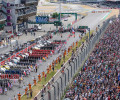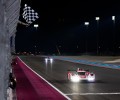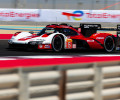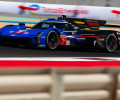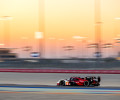AUTO #15 - ROAD TO LE MANS

Each year, in the week before the main event, the Place de la République in Le Mans buzzes with an energy impossible to replicate at any other time of the year. In advance of motor sport’s most legendary endurance race, and on the day known as Le Pesage, an ever-more exclusive parade of racing machinery is wheeled between the crowd barriers for scrutineering by race officials.
But amid the steady stream of marquee sportscar brands that make up the majority of competitors at this most classic of races, it is the manufacturer prototypes, the monsters of endurance racing’s top LMP1 category, that draw the most attention, the most intakes of breath, the greatest number of camera phone flashes.
That the handful of manufacturer prototypes on show garner the lion’s share of the spotlight is unsurprising. These are, after all, creatures occupying an ultra-rarefied space, the product of multi-millions of dollars’ worth of development and testing and driven by the sport’s unalloyed celebrities – such as Porsche’s former F1 star Mark Webber, Toyota’s clutch of F1 drivers including former WEC champions Anthony Davidson and Sébastien Buemi, and Audi’s triple Le Mans winners André Lotterer and Benoît Tréluyer.
However, while the battle between racing powerhouses such as Porsche, Audi and Toyota undoubtedly drives the popularity of the FIA World Endurance Championship and its flagship 24 Heures du Mans event, the white hot glare surrounding LMP1 often serves to obscure what might be the heart and soul of sportscar racing – a vibrant LMP2 class filled with privateer teams that not only embody an enduring passion for competition at its purest, but which make up the backbone of a thriving motor sport industry.
Take Britain’s Jota Sport. The drive up to the 2014 Le Mans LMP2 class winner’s headquarters is markedly different to the approach to LMP1 kingpins Porsche’s Weissach HQ. While the manufacturer’s facility is a vast, gleaming statement of engineering prowess and innovation, the road to Jota’s factory involves a slow wind through the sleepy byways of southern England’s Kentish countryside and a short detour down a lane to a small collection of industrial buildings on the edge of a farm. Here, it is a case of function over form, of purpose over posturing.
But while the facility might lack visual impact, inside it is a hive of industry as, for the first time in its 15-year-plus history, the team sets about preparing to run two different cars across two different championships.
“We were running our LMP2 programme quite comfortably,” explains team boss Sam Hignett, who in 2000 set up Jota on the edge of his parents’ farm primarily to service his own aspiration as a financially-straitened racing driver.
“However, last year, with the new LMP2 regulations coming in for 2017, it became apparent at Le Mans that [the team’s long-standing chassis supplier] Gibson weren’t going to tender for being one of the series’ four chassis manufacturers. We had to make some choices.”
The result is a split programme, with the team running a Nissan-powered Gibson 015 in the European Le Mans Series but also opting to forge a new relationship with one of the WEC’s selected constructors – Oreca. “I bought Gibson/Zytek’s first car and their last one,” recalls Hignett fondly. “We’ve book-ended that project and I attribute a third of our success to the relationship we have with Gibson. But we needed to be careful about the future.
“If we had carried on solely with Gibson in 2016 and had success, who are we at the end of the year other than another bunch of guys with a cheque for a couple of million euros to buy cars in 2017? So the only viable business solution was to do something with Oreca. They were the only people who had a semi-2017 compliant car on the ground at that stage, so we bought the Oreca quickly.”
TWO-PRONGED ATTACK
The decision by Hignett and his partners was planned as a twin assault on the ELMS series, but late last year a second partnership opened up with 2015 LMP2 champion G-Drive. The Russian company ended its relationship with the Oak team, installed Jota to run its programme and the Oreca chassis was switched to a WEC campaign.
The twin assault has led to rapid expansion at Jota’s facility, with the squad more than doubling in size from 10 employees to 24. This, explains Hignett, was made necessary by the demands of running the Gibson and the Oreca.
“Fundamentally the engine is the same. It’s the Nissan NISMO engine but there is a gentleman’s agreement that if you buy a Gibson chassis you run the Gibson version of the NISMO engine,” he says. “If you buy an Oreca chassis you run the Oreca version. So we are in a unique position where we have the same engine built by two different companies with two different sets of engineers, etc.”
The increase in commitment might seem small compared to manufacturer works programmes involving hundreds of people, but for team manager Gary Holland, who joined at the start of this year, the compact nature of LMP2 teams is part of the allure. “Here you are more connected to the racing as part of a smaller team,” says Holland, who tasted F1 glory as part of the 2009 title-winning Brawn GP team. “Although we are small from a footprint point of view, we are efficient, because we’re not heavily staffed.
“The atmosphere of not only an LMP2 team, but an endurance team, is completely different,” he adds. “It’s more informal. Everybody’s got a name. You’re not just a number on a rota or a pit pass. Every single person makes a difference and I like the fact that the way we motivate those people has a direct bearing on our end result. We can steer quickly, too; we’re reactive, and it’s probably more of a fast-paced environment [than F1] because fewer people are involved in more projects so the multi-tasking side of it is huge.
“It would mean more to me to win Le Mans and the WEC and ELMS this year than it did to win the F1 championship, just from a personal point of view, because more things have to fall into place in order for that to happen.”
COMPETITION AT ITS PEAK
Making those things fall into place is the task of sporting director, Bob Friend, who admits that in the build-up to the start of the season the team was at full stretch.
“Once we’re into the season properly, then we can assess things,” he says. “At the moment, you’re so deep in it, you can’t even see the next step! When it’s all laid out at Le Mans you can look in the garage and say, “OK, we’ve made it, we look great and we’re going to make this work for the two cars.’ Only then will it feel ready!”
One of the founding members of the team, Friend has seen the privateer LMP category change dramatically over the past decade. “It’s so much better now,” he smiles. “Up until about 2006 or ’07 it was a race of attrition. To be honest, LMP2 cars were pretty rubbish. They’d fall to bits. You’d come in, change the parts on the gearbox, fix the broken suspension and so on. But what you’re seeing now with LMP2 technology and reliability is that it’s pushing the whole thing. We push the guys in the pit stops to be faster. The drivers need to be on it all the time. There’s no, ‘oh, they’re bound to come into the pits for half an hour and we’ll make back the three laps we’ve lost.’ You can’t rely on that any more. You’ve got to push the whole time.”
The solidity of LMP2’s racing platform is reflected in the strength of the 2016 grid, one of the most closely matched for some time. Ten LMP2 cars are contesting the full 2016 WEC campaign, with Jota being joined by stellar names such as the Nissan Renault Alliance’s famed Alpine marque, perennial WEC challengers Strakka and the Manor team run by former F1 team bosses Graeme Lowdon and John Booth. It’s a contest that G-Drive’s 2015 LMP2 champion Roman Rusinov believes is impossible to call. “The competition in LMP2 will be very tough, but very nice,” said Rusinov during pre-season testing. “All the cars on the entry list can challenge for the win, so we will have a very nice competition this year.” Jota Sport’s hard work was rewarded at the opening WEC round, the 6 Hours of Silverstone, in April. Rusinov and team-mates Nathanael Berthon and René Rast finished third in class, while in the ELMS former F1 driver Giedo van der Garde, 2014 Le Mans LMP2 winner and ex-Nissan LMP1 racer Harry Tincknell, and Jota partner and Tincknell’s fellow Le Mans winner Simon Dolan took the outright victory.
LOOKING TO THE FUTURE
While the season kicks into gear with the ELMS team heading to Imola and the WEC programme visiting the legendary Spa-Francorchamps before they are reunited at Le Mans in mid-June, Hignett is already looking ahead towards further expansion. “As a business, our goal is to be the first phone call when an automotive manufacturer decides they want to go LMP1 racing,” he says. “For that you need to be successful – and we’ve had a fantastic couple of years at Le Mans with a first and a second – but you also need to be on a world stage, hence the WEC. You also need to be running two cars. “This programme enables us to tick more boxes for what we perceive a manufacturer would look at,” he says. “If we can come out of this year with a good result in the WEC and at Le Mans, and we’ve proved we can house a big commercial entity in G-Drive, then if a manufacturer decides they want to go LMP1 or GTE racing, we’ll be well positioned to get that call. “Meanwhile, we’ll continue in LMP2. It’s a fantastic category,” he adds. “The FIA and ACO have got it absolutely spot on. It is expensive, but there are plenty of us doing it, so we are finding the money. We all moan and whinge, as every race team does, but when push comes to shove we’re all there.” And ultimately the reason for being there is simple, according to Gary Holland. “There are a number of events that everybody who’s ever worked in motor sport wants to win – the Monaco Grand Prix in Formula One, the Bathurst 1000, Pikes Peak, Paris-Dakar, the Monte Carlo Rally, the Indianapolis 500, Daytona, Sebring... But I believe Le Mans is right near the top of that list. Maybe it’s because I’m so immersed in it, but I think it’s one of the greatest achievements anyone could aspire to in motor sport. It’s just a legend.”
And it is a legend that spreads infinitely wider than the hothouse racing of the star-studded manufacturer prototypes. It’s alive and thriving in quiet corners of England and France, the United States and Russia, where small groups of men and woman pursue an often lonely dream. Lonely, but just as big and just as important
Click here to read this issue online.

 Facebook
Facebook Twitter
Twitter
